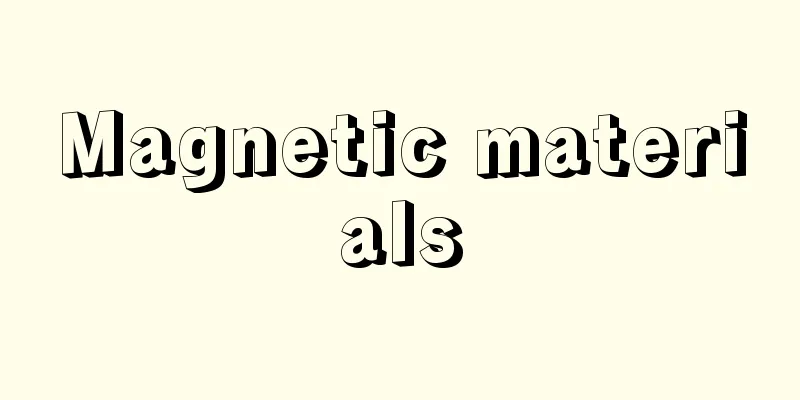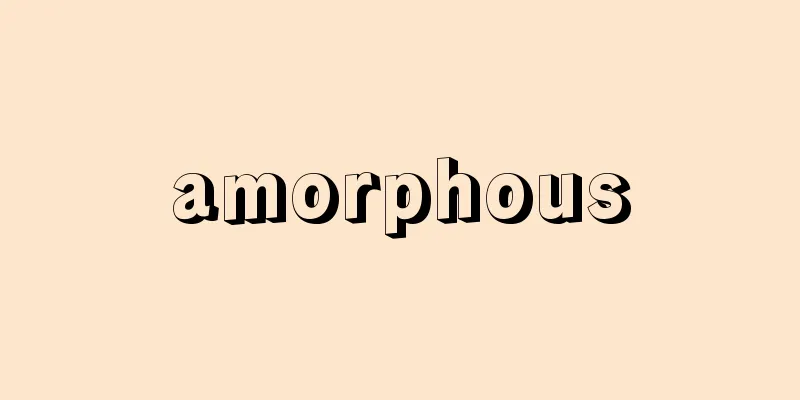Magnetic materials

|
This refers to materials that perform magnetic functions in products such as compasses, magnetic pins, electromagnets, motors, generators, speakers, transformers, or magnetic tapes, magnetic disks, cards, etc. Magnetic materials include ferromagnetic and ferrimagnetic materials that exhibit strong magnetic properties (hereafter referred to as magnetic bodies), and their magnetic properties differ depending on the purpose of use. Magnetic materials have a magnetic field due to the movement of electrons. This is called spontaneous magnetization. Spontaneous magnetization is divided into areas called "magnetic domains" and is arranged in such a way that it cancels out magnetic fields, so overall it appears as if there is no magnetic field. However, when an external magnetic field (H) is applied, the spontaneous magnetization aligns in the direction of the magnetic field, just as a compass needle points north to south due to the earth's magnetic field. This phenomenon is called "magnetization." The curves that show the relationship between magnetic field and magnetization are the magnetization curve and magnetic hysteresis curve. Magnetic materials are classified according to the differences in magnetic properties shown by these curves. Soft magnetic materials have a small coercive force and are easily magnetized. They are used as magnetic cores for electromagnets, transformers, motors, magnetic heads, etc. Many of them are used in alternating magnetic fields, so magnetization is repeated according to the frequency. At that time, magnetic energy equivalent to the loop area of the magnetic hysteresis curve is consumed. In particular, metallic magnetic materials have low electrical resistance, so energy loss due to eddy currents is accompanied. In order to reduce magnetic energy loss, the coercive force is made small and the loop area is made small. To reduce eddy current loss, it is devised to make thin plates with electrically insulated surfaces and use them in layers. For use at even higher frequencies, soft magnetic materials based on oxides, which have higher electrical resistance than metals, are used. In contrast, hard magnetic materials require high coercive force so that the spontaneous magnetization aligned in one direction does not demagnetize. Permanent magnets are a typical example, and are broadly divided into alloys and compounds. In alloys, ferromagnetic particles such as iron, cobalt, and nickel are dispersed in a non-magnetic material. In the compound system, magnetic compounds with large crystalline magnetic anisotropy are used. A magnetic material with coercive force is attached to the surface of magnetic recording tapes and disks as a recording medium. Sound and images are recorded on it as a micro-magnetic field. As recording density increases, magnetic materials with higher coercive force have come to be used. Semi-hard magnetic materials have a smaller coercive force than hard magnetic materials and are easier to magnetize and demagnetize than hard magnetic materials, so they are used in self-holding electromagnetic switches and rotors of hysteresis motors. Other magnetic materials include magnetic sensors that utilize the change in electrical conductivity due to magnetization, temperature sensors that utilize the fact that spontaneous magnetization disappears at the Curie temperature and no longer reacts to external magnetic fields, magnetostrictive sensors that utilize the change in magnetic susceptibility due to stress, magnetic oscillators that utilize the fact that when a magnetic material with large magnetostriction is magnetized with an AC magnetic field, it vibrates in response to the frequency of the magnetic field, invariant alloys (Invar alloys) that utilize the fact that the change in volume with temperature becomes small near the Curie temperature, magnetic fluids in which fine magnetic particles are dispersed in a liquid, and various other elements that utilize the relationship between light, electromagnetic waves, and magnetic fields. [Motofumi Homma] [Reference] |Source: Shogakukan Encyclopedia Nipponica About Encyclopedia Nipponica Information | Legend |
|
方位磁針、磁石ピン、電磁石、モーター、発電機、スピーカー、トランス、あるいは磁気テープ、磁気ディスク、カードなどの製品において、磁気的な機能を受け持っている材料をいう。磁性材料には、強い磁気を示す強磁性やフェリ磁性(以下、磁性体という)が用いられ、使用目的によって磁気特性が異なる。 磁性体には電子の運動による磁界が存在している。それを自発磁化という。自発磁化は「磁区」という領域によって区分され、磁界を打ち消すように配列しているので、全体としては磁界がないようにみえる。しかし外部から磁界(H)を加えると、方位磁針が地磁気によって南北をさすように、自発磁化が磁界の方向にそろってくる。この現象を「磁化」という。磁界と磁化との関係を示す曲線が磁化曲線や磁気ヒステリシス曲線である。 磁性材料は、それらの曲線で示される磁気特性の相異によって分類される。軟質磁性材料は保磁力が小さく磁化されやすい材料で、電磁石、トランス、モーター、磁気ヘッドなどの磁心として用いられる。それらの多くは交流磁界中で用いられるので、周波数に応じて磁化が繰り返される。そのとき磁気ヒステリシス曲線のループ面積に相当する磁気エネルギーが消費される。とくに金属磁性材料では電気抵抗が低いので、渦電流によるエネルギーの損失が伴う。磁気エネルギーの損失を低減するために保磁力を小さく、ループ面積を小さくしてある。渦電流の損失の低減には、薄板にして表面を電気的に絶縁し重ねて用いるなどくふうされている。さらに高い周波数で用いる場合には、電気抵抗が金属よりも高い酸化物系の軟質磁性材料を用いる。これに対して、硬質磁性材料は、一方向にそろえた自発磁化が減磁しないように高い保磁力が必要である。永久磁石がその典型であって、合金系と化合物系に大別される。合金系では鉄、コバルト、ニッケルなどの強磁性粒子が非磁性体に分散している。化合物系では結晶磁気異方性の大きな磁性化合物を用いる。磁気記録用のテープ、ディスクの表面には保磁力を有する磁性材料が記録媒体として付着させてある。それに音や画像が微小磁界として記録される。記録密度の上昇に伴って保磁力のより高い磁性体が用いられるようになった。半硬質磁性材料は硬質磁性材料に比較して保磁力が小さく、着磁、減磁が硬質磁性材料よりも容易であって、自己保持型の電磁開閉器やヒステリシスモーターの回転子に用いられる。 それら以外の磁性材料としては、磁化によって電気伝導度が変化することを利用した磁気センサー、キュリー温度で自発磁化が消失し外部磁界に反応しなくなることを利用した温度センサー、応力によって磁化率が変化することを利用した磁気ひずみセンサー、磁気ひずみの大きい磁性体を交流磁界で磁化するとき、その周波数に対応して振動することを利用した磁気振動子、キュリー温度近傍で体積の温度変化が小さくなることを利用した不変合金(インバー合金)、磁性体の微粒子を液体中に分散した磁性流体、さらには光、電磁波と磁界との関係を利用した種々の素子がある。 [本間基文] [参照項目] |出典 小学館 日本大百科全書(ニッポニカ)日本大百科全書(ニッポニカ)について 情報 | 凡例 |
<<: Illegitimate Child - Shiseiji
Recommend
Aganyok - Aganyok
...It was published 365 days a year in 44 cities,...
Keyboard - kiboudo (English)
A device that has keys for letters, numbers, symb...
Jyväskylä - Yubasukyura (English spelling) Jyväskylä
A city in central Finland. It is located at the n...
Citizen (English spelling)
A city is a person who enjoys the privileges of t...
Active path corrosion
...This type of cracking occurs in bullet cartrid...
Acer pycnanthum (English spelling) Acerpycnanthum
… [Ken Ogata]. . … *Some of the terminology that ...
Capogrossi, G. (English spelling) CapogrossiG
...The works of Fautrier and Bors during and imme...
Supply-side economics
… [Inflation and tax rates] In the 1970s, Western...
Amygdalin
...The fruits are eaten raw, dried, preserved in ...
No regrets about my youth
A Japanese film released in 1946. Directed by Akir...
Daimukenzan - Daimukenzan
Also called Daimugenzan. Located in the central-no...
Merluccius bilinearis (English spelling)
…[Hibiya Kyo]. . . *Some of the terminology that ...
Miniature books - Mamehon
An extremely small book. In the West, it is calle...
Japanese literature
The Japanese people, surrounded by the sea, have ...
Bordeaux mixture
A homemade fungicide made from copper sulfate and...









